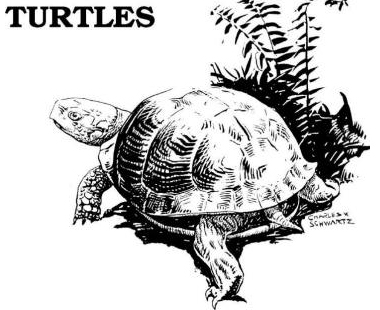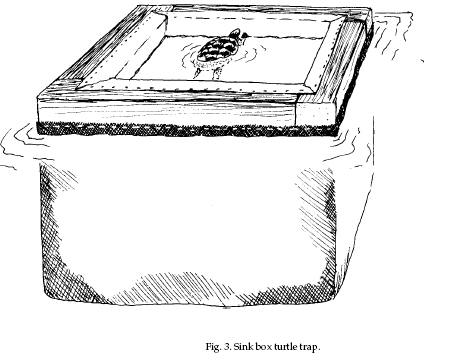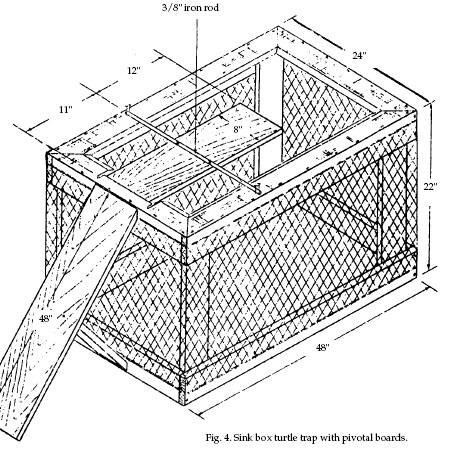|
|
|
|
 |
REPTILES, AMPHIBIANS, ETC: Turtles |
|
|

Fig. 1. Eastern box
turtle, Terrapene carolina
Identification and Range
Turtles occur on all
continents except Antarctica. Over 240 species occur
worldwide but turtles are most abundant in eastern North
America. Most turtles have good field characteristics
that are visible and can be easily identified. Some
species, however, require close examination of the
shields on the plastron (underside shell) for a positive
identification.
General Biology, Reproduction, and Behavior
Any permanent body of
water is a potential home for turtles. Some species will
also tolerate brackish water, but the sea turtles are
the only true saltwater species.
Unlike most other turtles,
including soft-shells, snapping turtles rarely bask.
Turtles feed on a combination of plant and animal
material that includes items such as aquatic weeds,
crayfish, carrion, insects, fish, and other small
organisms. The diet of snapping turtles, however,
usually includes a relatively high proportion of fish.
They are relatively aggressive predators, occasionally
known to take fish off fish stringers.
All turtles reproduce by
laying eggs in early spring. Hatching begins in late
summer and extends into the fall, depending on summer
temperatures associated with the climate of the range.
During winter, turtles usually bury themselves in soft
mud or sand in shallow water with only the eyes and
snout exposed.
Turtles are easy prey for
a number of predator species such as alligators, otters,
raccoons, and bears. Humans are probably the greatest
threat to turtle populations, particularly for the most
commercial species, such as snappers and soft-shells.
Damage
Turtles are seldom a pest
to people. Turtles are very beneficial and of economic
importance, except in certain areas such as waterfowl
sanctuaries, aquaculture facilities, and rice fields in
the south. Indiscriminate destruction of turtles is
strongly discouraged, and every effort should be made to
ensure that local populations are not exterminated
unless it can be clearly demonstrated that they are
undesirable.
Some species of pond and
marsh turtles are occasional economic pests in rice
fields in the south. Their feeding activity on young
rice often results in significant yield reductions in
local areas.
In farm ponds, turtles
undoubtedly compete with fish for natural food sources
such as crayfish and insects. Turtles, however, are
valuable because they kill diseased and weakened fish,
and clean up dead or decaying animal matter.
In commercial aquaculture
production ponds, turtles can eat fish that are being
grown. They also eat fish food. Aquaculture ponds are
not the preferred habitat of turtles, however. The heavy
clay soils required for pond construction are not
conducive to the turtles’ laying of eggs.
Legal Status
Most turtles are not
protected by state laws. Licenses usually are required
for commercial fishing and sale of turtles. Before
taking turtles, contact a state wildlife or conservation
agency representative for legal status.
There were two turtles
listed by the US Fish and Wildlife Service as endangered
or threatened species as of December 1992. The desert
tortoise was listed as threatened everywhere except for
a population in Arizona. Its historic range is Arizona,
California, Nevada, and Utah. The gopher tortoise was
listed as threatened wherever found west of the Mobile
and Tombigbee rivers in Alabama, Mississippi, and
Louisiana. Its historic range is Alabama, Florida,
Georgia, Louisiana, Mississippi, and South Carolina.
Five freshwater turtles
were listed by the US Fish and Wildlife Service as
endangered or threatened species as of December 1992.
The Alabama red-bellied turtle and the flattened musk
turtle were listed as endangered and threatened,
respectively. Alabama is the historic range of both
species. The ringed sawback turtle is threatened in its
historic range of Louisiana and Mississippi. The
yellow-blotched map turtle is threatened in its historic
range of Mississippi. The Plymouth red-bellied turtle is
endangered in its historic range of Massachusetts.
Additional species under
review include the alligator snapping turtle, bog
turtles, and the western tortoises.
Damage
Prevention and Control Methods
Cultural Methods
The best control for box,
pond, and marsh turtles in rice fields is to drain
irrigation canals and fallow fields during winter
months. Without a permanent water source year-round,
these species do not reach large enough populations to
become a serious economic problem.
Ponds that are used for
the production of channel catfish or other finfish are
routinely harvested by seining. The seining process will
also capture turtles. Farmers can control turtle
populations by moving these captured turtles to their
natural habitats.
Repellents, Toxicants, and
Fumigants
None are registered.
Trapping
Since turtles generally
are not a pest to people, control measures are limited
primarily to trapping. Trapping can be used quite
effectively to reduce local populations of these species
where damage occurs.
The best place to trap
turtles is in the quiet water areas of streams and
ponds, or in the shallow water of lakes. Soft-bottom
areas near aquatic vegetation are excellent spots.
The best seasons for
trapping are spring, summer, and early fall. Most
turtles hibernate through the winter, except in the
extreme south, and do not feed, making trapping
ineffective. Methods of trapping are described for
various types of turtles in the following sections.
Traps should be baited
with fresh fish or red meat. Catfish heads and cut carp
are regarded as two of the best baits available for
trapping turtles. Baits should be suspended in traps on
a bait hook or placed in bait containers for maximum
effectiveness. In areas where turtle populations are
high, it is often necessary to check traps two or three
times per day and add fresh bait, since turtles are
capable of consuming large quantities of bait rather
quickly.
Snapping and Soft-Shell
Turtles.
While snapping turtles are
in hibernation, they often can be taken in quantities
from spring holes and old muskrat holes, under old logs,
and in soft bottoms of waterways. Turtle collectors rely
on their hunting instincts and experience to locate
hibernating turtles. When one is found, it pays to
explore the surrounding area carefully because snappers
often hibernate together. The method for capture, known
as noodling or snagging, requires a stout hook. One end
of an iron rod is bent to form a hook and sharpened; the
other end of the rod is used for probing into the mud or
soil to locate the turtles. The hunter probes about in
the mud bottom until a turtle is located (which feels
much like a piece of wood) and then pulls it out with
the hook. Turtles are inactive during the winter and
offer little resistance to capture, although the landing
of large ones may be difficult even for experienced
hunters.
Snappers and soft-shelled
turtles are sometimes taken on set lines baited with cut
fish or other fresh meat. One recommended device is made
by tying 4 or 5 feet (1.2 or 1.5 m) of line to a stout
flexible pole, 6 to 8 feet (1.8 to 2.4 m) long. About 12
inches (30.5 cm) of No. 16 steel wire is placed between
the line and the hook, preferably a stout hook about 1
inch (2.5 cm) across between barb and shaft. The end of
the pole is pushed into the bank far enough to make it
secure at an angle that will hold the bait a few inches
(cm) above the bottom.
Snappers and soft-shelled
turtles may also be taken readily in baited fyke or hoop
nets (Fig. 2). These barrel-shaped traps may sometimes
be purchased on the market or made from 3-inch (7.6- cm)
square mesh of No. 24 nylon seine twine. The trap should
be 4 to 6 feet (1.2 to 1.8 m) long from front to back
hoop. The three to five hoops per trap be approximately
30 inches (76 cm) in diameter, made of wood or 6-gauge
steel wire with welded joints. The funnel-shaped mouth
should be 18 inches (46 cm) deep from the front hoop to
the opening inside. The entrance opening of the funnel
should be 1 inch x 20 inches (2.5 x 51 cm). The corners
of the opening are tied by twine to the middle hoop. The
rear or box end may be closed with a purse string. After
the hoops have been installed, the net should be treated
with a preservative of tanbark, cooper oleate, tar, or
asphalt. To keep the trap extended, stretchers of wood
or steel wire, about 9 gauge or larger, are fastened
along each side.
Coarse mesh poultry wire
may be substituted for the twine. If this is done, the
frame will be approximately 30 inches (76 cm) square.
The shape and dimensions of the entrance as specified
should be the same in all traps, as it is easily
negotiated by the turtles. The dimensions of the trap
may be altered for ease of transportation. A door may be
installed in the top to facilitate baiting and removal
of turtles. Entrance funnels may be placed on each end
if desired.
Fyke or hoop turtle traps
should be set with the tops of the hoops just out of the
water. This will permit the turtles to obtain air and
lessen their struggles to escape, and will enable other
turtles to enter the trap more freely. It is necessary
to set traps this way if the turtles are to be taken
alive. Traps set in streams must be anchored. If the
water is too deep for the top of the trap to be out of
the water, short logs can be lashed to each side to
float the trap. Turtles enter more readily when the
mouth of the trap is set downstream.
Box, Pond, and Marsh
Turtles. Because of their habits, these species must
be captured with methods different from those for
snapping and softshelled turtles. They cannot be taken
in numbers during the winter, like snappers, because
they do not congregate in their hibernating places. In
the summer some species are gregarious, crowding
together in numbers on projecting logs and banks.
 By
takingadvantage of this fact, these basking species may
be taken by trapping in a box sunk in a place the
turtles are using. The turtles crawl up onto the top of
the box to bask in the sun, and many of them fall into
the trap (Fig. 3). By
takingadvantage of this fact, these basking species may
be taken by trapping in a box sunk in a place the
turtles are using. The turtles crawl up onto the top of
the box to bask in the sun, and many of them fall into
the trap (Fig. 3).
The top frame of the box
may be constructed from discarded telephone poles,
imperfect ties, or logs about 8 inches (20 cm) in
diameter. Old natural unpainted wood is preferred. The
logs are mitered at each end to fit together, and the
inside enclosure made to measure 2 to 3 feet (61 to 91
cm) square. About half of each log from the top center
to the inside under center is lined with zinc or
galvanized metal. Turtles that have dropped into the
trap are unable to climb over the zinc or galvanized
metal covering. From the outside water edge to the top
of each
 log,
cleats can be nailed or the logs made rough, so turtles
can easily climb on top. Galvanized mesh wire can be
fastened to the logs with staples, hooks, or wire to
form a wire basket fitting the opening between the logs.
One-inch (2.5-cm) mesh is about right if all sizes of
turtles are to be trapped. If only larger specimens are
sought, however, a 3-inch (7.6-cm) mesh can be used. The
trap should be fastened to a stump or some other
permanent anchor. log,
cleats can be nailed or the logs made rough, so turtles
can easily climb on top. Galvanized mesh wire can be
fastened to the logs with staples, hooks, or wire to
form a wire basket fitting the opening between the logs.
One-inch (2.5-cm) mesh is about right if all sizes of
turtles are to be trapped. If only larger specimens are
sought, however, a 3-inch (7.6-cm) mesh can be used. The
trap should be fastened to a stump or some other
permanent anchor.
Some trappers prefer to
use bait; others leave the traps unbaited. For the
capture of snapping and soft-shelled turtles, the trap
can be modified by installing funnel-like entrances on
one or two sides as described for the hoop traps.
Another type of trap
consists of a box with an inclined board leading up to
it. The turtles climb up on the board to bask and drop
off into the box. Figure 4 shows the same trap with
pivotal boards placed so that turtles crawling out on
the boards overbalance on the terminal end and are
dropped into the box.
Shooting
In some states, shooting
can also be used as a means of reducing populations in
ponds and lakes. This technique, however, is not very
effective.
Economics of Damage and Control
Three groups of turtles
are of economic importance in North America. They
include the snapping turtles; the box, pond, and marsh
turtles; and the soft-shelled turtles. Snapping turtles
are trapped for human consumption and are being
considered for aquaculture. Red-eared turtles are
cultured for the foreign pet trade. Soft-shell turtles
are also trapped for human consumption.
Damage is typically of
little economic concern, but may be a problem in rice
and aquacultural production.
Acknowledgments
Figure 1 from C. W.
Schwartz: Wildlife Drawings (1980), Missouri Department
of Conservation, Jefferson City.
Figures 2 through 4 from
Wildlife Damage Control Handbook (1969), Kansas State
University, Manhattan. Adapted by Emily Oseas Routman.
For Additional Information
Conant, R., and J. T. Collins. 1991. A field guide to
reptiles and amphibians: eastern and central North
America. 3d ed. Houghton Mifflin Co. Boston. 450 pp.
Ernst, C. H., and R. W.
Barbour. 1972. Turtles of the United States. Univ.
Kentucky Press, Lexington. 347 pp.
Stebbens, R. L. 1985. A
field guide to western reptiles and amphibians. 2d ed.
Houghton Mifflin Co., Boston. 279 pp.
Editors
Scott E. Hygnstrom Robert
M. Timm Gary E. Larson
PREVENTION AND CONTROL OF
WILDLIFE DAMAGE — 1994
Cooperative Extension
Division Institute of Agriculture and Natural Resources
University of Nebraska -Lincoln
United States Department
of Agriculture Animal and Plant Health Inspection
Service Animal Damage Control
Great Plains Agricultural
Council Wildlife Committee
01/26/2007
Special
thanks to:
Clemson University
|